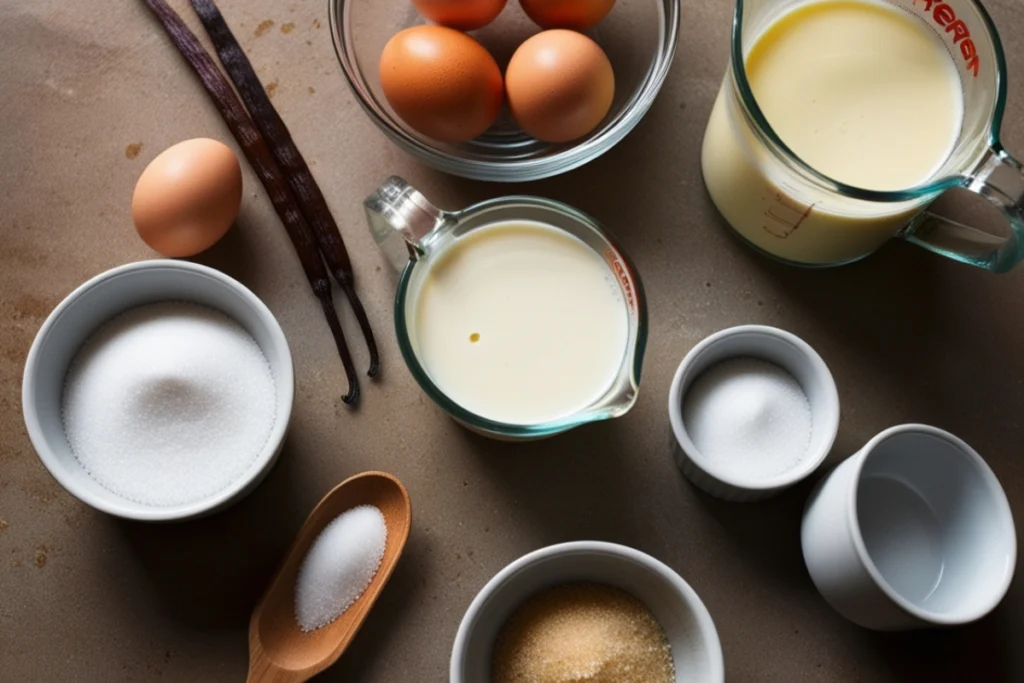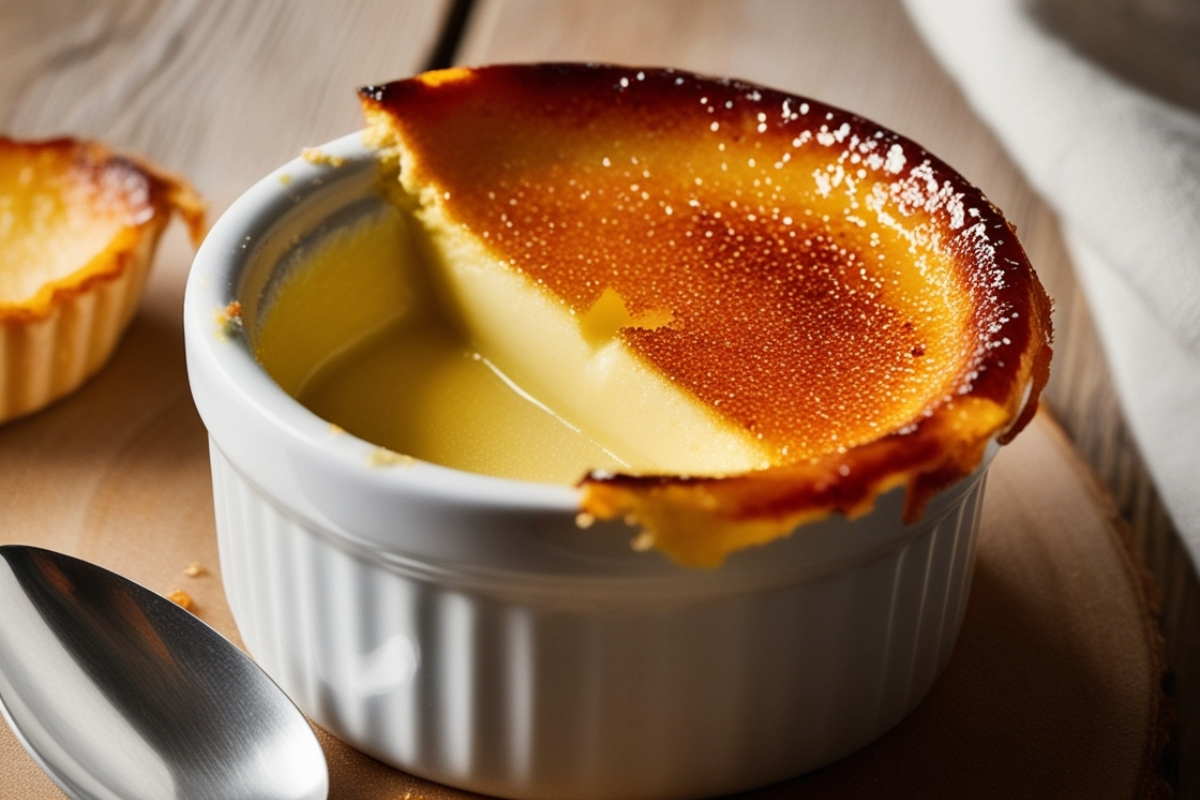So, what is the secret to crème brûlée? This iconic dessert, known for its creamy custard base and crisp caramelized sugar topping, has captivated taste buds for centuries. But what exactly makes it so irresistible? Is it the silky-smooth texture, the delicate sweetness, or perhaps the satisfying crunch that comes with breaking through that golden sugar crust?
In this guide, we’ll carefully uncover the secrets to achieving the perfect crème brûlée, step by step. From its fascinating history and essential ingredients to foolproof techniques, we’ll walk you through everything you need to know. By the end, you’ll have the confidence to create this luxurious dessert at home.
So, if you’ve ever wondered how to achieve that dreamy balance of creamy custard and crackling sugar, you’re in the right place. Get ready to impress yourself—and anyone lucky enough to try it! Let’s dive in!
Jump ahead to:
The Origins and History of Crème Brûlée
Crème brûlée might seem like a modern culinary treasure, but its roots stretch far into history. This classic dessert, known for its delicate balance of silky custard and crisp caramelized sugar, has traveled far and wide, leaving a trail of curiosity and admiration.
A Classic French Dessert
Despite its widespread association with French cuisine, crème brûlée’s origins are a bit murky—almost as mysterious as its irresistible charm. The phrase crème brûlée translates to “burnt cream”, perfectly describing its iconic caramelized topping. Its first recorded appearance dates back to the late 17th century in France, where it was served to royalty and aristocrats as a luxurious treat.
What makes this dessert so distinct? It’s simple: the combination of three primary components—egg yolks, heavy cream, and sugar—transforms into something extraordinary with just the right preparation. The finishing touch, that beautifully caramelized sugar layer, is both its signature and secret.
The French elevated crème brûlée into an art form, emphasizing technique, precision, and presentation. But it wasn’t just the French who contributed to its legacy. Similar variations, like Catalan cream in Spain or Trinity cream in England, hint at a more shared European influence.
Evolution and Popularity Around the World
While crème brûlée may have started as a dish reserved for the elite, it has become a beloved dessert across the globe. From Michelin-star restaurants to cozy family kitchens, its elegance and simplicity make it universally appealing.
During the late 20th century, crème brûlée experienced a renaissance in the culinary world. Chefs worldwide began experimenting with unique flavors and presentations while staying true to the traditional techniques. Variations like chocolate crème brûlée, matcha-infused versions, and even citrus blends brought a contemporary twist to the classic dessert.
What propelled its popularity? For one, its visual allure—a golden, glass-like sugar crust ready to be cracked with a spoon—captures the imagination. Additionally, the contrast between the crunchy sugar and the smooth, rich custard creates an unforgettable textural experience.
Nowadays, crème brûlée remains a staple dessert in fine dining establishments and a go-to recipe for home bakers looking to impress. The beauty of this dish lies in its simplicity, yet achieving that perfect balance can feel like unlocking a culinary secret. And therein lies the magic: crème brûlée isn’t just a dessert; it’s an experience.
The Core Ingredients You Need

At its heart, crème brûlée relies on only a handful of ingredients—each playing a vital role in delivering that smooth, luscious custard topped with crisp, caramelized sugar.
The Role of Egg Yolks in Custard
Egg yolks are the backbone of a perfect crème brûlée. Acting as a thickening agent, they give the custard its rich and velvety texture while ensuring it sets correctly.
Why just yolks and not whole eggs? The proteins in egg yolks coagulate gently, thickening the custard without making it too firm or rubbery. Adding whole eggs, on the other hand, introduces egg whites, which can make the texture too stiff or uneven.
For the best results, use fresh, high-quality egg yolks. A good rule of thumb is about 4–6 yolks per 2 cups of cream, striking the perfect balance between silky smooth and set. Be sure to whisk them gently—overbeating adds unwanted air bubbles, which can ruin the creamy consistency.
Heavy Cream vs. Milk for Smoothness
When it comes to crème brûlée, heavy cream reigns supreme. The richness of cream, with its higher fat content, gives the custard its luxurious texture. It creates a velvety, melt-in-your-mouth sensation that milk alone cannot achieve.
But wait—can you use milk? Technically, yes, but it comes with compromises. Milk lacks the fat needed for that signature smoothness, often resulting in a thinner, less satisfying custard. If you’re trying to lighten things up, a 3:1 mix of heavy cream to whole milk is a decent compromise, but nothing beats pure cream.
For the creamiest result:
- Use full-fat heavy cream or whipping cream (at least 35% fat).
- Warm the cream slightly before mixing it with the yolks—this helps the custard combine smoothly.
Remember, the quality of cream matters, too. Opt for fresh, high-quality cream to let the rich flavors shine.
Adding Flavor to Crème Brûlée
A classic crème brûlée relies on subtle, sophisticated flavors that enhance its natural richness. While the traditional vanilla remains timeless, there’s no harm in getting creative!
Vanilla Beans: A Traditional Flavor Choice
Vanilla is synonymous with crème brûlée, and for good reason. The warm, aromatic essence of vanilla pairs perfectly with the custard’s creaminess, creating an elegant, balanced flavor profile.
Vanilla beans, rather than extracts or essences, are the gold standard. They provide a richer flavor and leave those tiny black specks of vanilla throughout the custard—a sign of authenticity and attention to detail.
How to use vanilla beans:
- Split a fresh vanilla pod lengthwise.
- Scrape the seeds out with a knife.
- Add the seeds and pod to your cream while heating it, infusing the custard with maximum flavor.
If vanilla beans aren’t available, a high-quality pure vanilla extract can work in a pinch. Just remember: artificial vanilla lacks the depth and complexity that fresh beans bring.
Alternative Flavors Like Chocolate, Coffee, and Citrus
Once you’ve mastered the traditional recipe, experimenting with alternative flavors is where the fun begins. These twists can elevate your crème brûlée to suit any occasion or palate.
- Chocolate Crème Brûlée:
Add melted dark chocolate or cocoa powder to the cream mixture for a rich, decadent twist. - Coffee-Infused Crème Brûlée:
Steep finely ground coffee or espresso beans in the cream to create a subtle, aromatic coffee flavor. Pair it with a sprinkle of cocoa powder for an added flourish. - Citrus Crème Brûlée:
Zest from oranges, lemons, or limes can brighten up the custard with a refreshing, tangy note. Add the zest to the cream as it heats, allowing the oils to infuse into the mixture. - Seasonal Flavors:
Experiment with spices like cinnamon, nutmeg, or even pumpkin puree for festive variations during the holidays.
While experimenting, it’s crucial to strike a balance—flavors should complement the custard without overpowering its natural richness.
With the right ingredients and flavor options in your arsenal, you’re well on your way to mastering this iconic dessert. Up next, we’ll dive into the techniques you need to perfect your crème brûlée, from creating the custard to achieving that irresistible caramelized sugar topping!
What is the Secret to Crème Brûlée Cooking Technique?
What is the secret to crème brûlée? The success of crème brûlée lies in gentle, precise cooking that allows the custard to set perfectly without curdling. While it sounds like a delicate balancing act, understanding and implementing the right techniques will make all the difference.
The Importance of a Water Bath (Bain-Marie)
A water bath, or bain-marie, is one of the most crucial elements when cooking crème brûlée. It’s a simple technique but absolutely essential for achieving the custard’s silky, smooth texture.
So, what is a water bath? It involves placing your ramekins in a baking dish filled with hot water. The water surrounds the custard, ensuring it cooks gently and evenly by maintaining a consistent, low temperature. Without a water bath, the direct oven heat can cause the custard to cook unevenly, resulting in an unpleasant, scrambled egg texture.
Here’s how to do it right:
- Place your filled ramekins in a deep baking dish.
- Boil water and carefully pour it into the dish until it reaches halfway up the sides of the ramekins.
- Cover the dish loosely with foil to retain moisture and ensure even cooking.
The water’s slow, steady heat prevents sudden temperature spikes, allowing the custard to cook slowly and achieve that perfect set—firm but still creamy. The secret to crème brûlée truly lies in mastering this technique!
How to Avoid Overcooking the Custard
Overcooking crème brûlée is one of the most common pitfalls, and it’s surprisingly easy to do if you’re not vigilant. The custard’s delicate nature means even a few minutes too long in the oven can make it grainy or curdled.
To prevent overcooking:
- Monitor the Temperature: The ideal internal temperature for crème brûlée is around 170–175°F (77–80°C). Use a food thermometer to check if you’re unsure.
- Watch for the Jiggle Test: When ready, the custard should look set around the edges but still jiggle slightly in the center. It will firm up further as it cools.
- Avoid High Temperatures: Bake at a low temperature—around 300°F (150°C). Slow and steady wins the race when it comes to custard.
Additionally, once baked, let the ramekins cool at room temperature before chilling them in the fridge. Rushing this process can cause uneven texture or condensation on the surface.
By carefully following these steps and understanding what is the secret to crème brûlée, you’ll avoid common pitfalls and ensure a perfectly smooth, creamy custard every time.
Caramelizing the Sugar Topping
The sugar topping is what transforms crème brûlée into an unforgettable experience. Achieving that perfect golden, crackly layer requires precision and the right tools. Let’s explore the best methods for caramelizing sugar to get that signature crunch.
Using a Kitchen Torch vs. Broiler Method
The most iconic part of crème brûlée is cracking through the caramelized sugar with a spoon, revealing the silky custard beneath. To get that delicate, glass-like sugar crust, you have two options: using a kitchen torch or your oven’s broiler.
- Using a Kitchen Torch:
A kitchen torch is the preferred tool for professionals and home cooks alike because it offers control and precision. Here’s how to do it:- Sprinkle an even, thin layer of granulated sugar over the custard surface. Shake the ramekin gently to distribute it.
- Ignite the kitchen torch and hold it a few inches from the sugar. Move it in small, circular motions, heating the sugar until it melts and turns golden brown.
- Avoid holding the flame in one spot for too long—this can burn the sugar unevenly.
- Using the Broiler Method:
If you don’t have a torch, don’t fret! You can use your oven’s broiler to caramelize the sugar. Here’s how:- Preheat the broiler to high.
- Place the ramekins on a baking sheet and sprinkle the sugar evenly on top.
- Broil the custards for 2–4 minutes, keeping a very close eye on them. Rotate the ramekins as needed to ensure the sugar caramelizes evenly.
While the broiler method works, it’s less precise and can sometimes heat the custard underneath, softening its texture. However, in a pinch, it’s an effective alternative.
Achieving the Perfect Golden Crackle
The key to a perfect sugar crust lies in the balance of technique and patience. Follow these tips for that satisfying “crack”:
- Use the Right Sugar: Granulated white sugar works best because it caramelizes evenly. Avoid brown sugar—it tends to burn before melting.
- Keep It Thin: A thin, even layer of sugar melts more predictably and forms a better crackle. Too much sugar will result in a thick, sticky topping.
- Serve Immediately: Caramelized sugar begins to soften after a while, so it’s best to serve crème brûlée shortly after torching.
A well-caramelized sugar topping should have a deep amber color, a crisp texture, and that telltale shatter when tapped with a spoon. It’s the final touch that elevates crème brûlée from a simple custard to a culinary masterpiece.
Perfecting the cooking techniques for crème brûlée takes patience, practice, and attention to detail. Up next, we’ll tackle the common mistakes people make and how to avoid them so you can ensure your crème brûlée turns out perfect every time!
Troubleshooting Crème Brûlée Mistakes
Preventing a Grainy or Overcooked Custard
A silky-smooth custard is the hallmark of a perfect crème brûlée, but overcooking can result in a grainy, scrambled-egg texture. Here’s how to avoid it:
- Use the Water Bath (Bain-Marie): As mentioned earlier, baking the custard in a water bath regulates temperature and ensures gentle, even cooking.
- Watch the Baking Time: Bake until the edges are firm but the center still jiggles slightly. Don’t overbake—it will continue to set as it cools.
- Monitor the Oven Temperature: Too much heat will cause the eggs to cook too quickly. Stick to a low temperature (around 300°F/150°C).
If your custard does turn out grainy, unfortunately, there’s no real fix. Prevention is key, so always bake with care.
How to Fix an Uneven Sugar Caramelization
Uneven caramelization happens when the sugar isn’t distributed properly or melts unevenly, leaving burnt or raw spots. Here’s how to perfect the golden crust:
- Use Fine, Granulated Sugar: It melts evenly and forms a thin, crisp layer. Avoid coarse or brown sugar.
- Spread the Sugar Evenly: Use a spoon or shake the ramekin gently to get an even layer.
- Keep the Torch Moving: Hold the torch a few inches away and move it in small, circular motions to avoid burning one spot.
- For Broilers: Rotate the ramekins frequently under the broiler to ensure even caramelization.
If you do end up with burnt sugar, gently scrape it off, sprinkle a fresh layer of sugar, and try again.
Serving Crème Brûlée the Right Way
Choosing the Perfect Ramekins
The choice of ramekin plays a significant role in both cooking and presentation. Here’s what to look for:
- Shallow and Wide Ramekins: These ensure the custard cooks evenly and allow for a generous caramelized sugar layer.
- Material Matters: Use ceramic or porcelain ramekins—they hold heat well and look elegant when served.
- Size: Standard ramekins are about 4–5 inches wide and 1–1.5 inches deep. Avoid deep ramekins; they make it harder to achieve an even sugar crust.
Presentation Tips for an Elegant Dessert
- Add a Touch of Garnish: Serve with a few fresh berries, a sprig of mint, or a light dusting of powdered sugar for a pop of color.
- Serve on a Platter: Place the ramekin on a decorative plate with a small spoon for a polished look.
- Chill Before Serving: Make sure the custard is cold, but the caramelized sugar is freshly torched and crisp.
When you crack through the golden crust and reveal the creamy custard underneath, you want your guests to experience that moment of pure joy. Presentation sets the tone for that indulgence.
What is the ideal temperature for crème brûlée?
What is the secret to crème brûlée? The ideal baking temperature is 300°F (150°C), which allows the custard to cook gently. The internal temperature should reach 170–175°F (77–80°C). Overcooking can cause the custard to curdle, ruining its silky texture.
How to get the perfect crème brûlée top?
To achieve the perfect sugar crust, use fine granulated sugar and caramelize it evenly with a kitchen torch or broiler. What is the secret to crème brûlée perfection here? Keep the flame moving to avoid burning and aim for a thin, golden-brown layer that cracks beautifully when tapped with a spoon.
What makes a good crème brûlée?
A good crème brûlée undeniably depends on achieving the perfect balance. The secret to crème brûlée lies in its flawlessly smooth, creamy custard with no lumps, complemented by a crisp, caramelized sugar topping that offers a delightful crunch when broken. At its core, it’s all about mastering precision in technique and having the patience to ensure every detail is executed to perfection!
How to mess up crème brûlée?
Wondering what not to do when making crème brûlée? Overcooking the custard, skipping the water bath, or unevenly caramelizing the sugar are common mistakes. If you’re asking “What is the secret to crème brûlée?”, the answer lies in careful technique, temperature control, and attention to detail.
What is the best sugar for crème brûlée?
The best sugar for crème brûlée is fine, granulated white sugar. So, what is the secret to crème brûlée topping? Well, it’s all about even melting and precise caramelization. Fine sugar melts smoothly, creating that thin, golden crust that cracks perfectly with a spoon. On the other hand, avoid brown sugar or coarse varieties—they tend to burn unevenly and can ruin the signature golden crackle that makes this dessert so special.
Can I make crème brûlée without a kitchen torch?
Absolutely! If you don’t have a torch, don’t worry—your oven’s broiler can work as a reliable substitute. Simply place the ramekins under the broiler for 2–4 minutes, making sure to rotate them carefully to achieve an even caramelization. Admittedly, it’s a bit trickier than using a torch, as you’ll need to keep a close eye to prevent burning. However, with a little patience and attention, it still works wonderfully for getting that beautifully crisp sugar topping.
With these expert answers, you now have a complete understanding of what is the secret to crème brûlée? Whether it’s achieving the perfect custard or caramelized sugar, the tips above will help you avoid pitfalls and make a flawless version of this iconic dessert. It’s time to grab your ramekins, follow the steps, and impress everyone with your newfound skills!
For more delicious and easy recipes, Discover More Recipes.


1 thought on “What is the Secret to Crème Brûlée? A Complete Guide to Perfect Texture and Flavor”